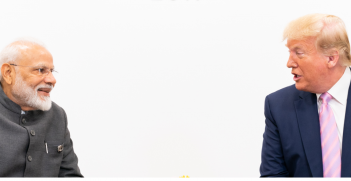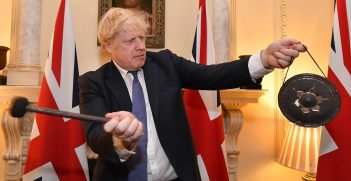Reconstructing Pharmaceutical Global Supply Chains after COVID-19

The COVID-19 outbreak provides India’s pharmaceutical industry a big opportunity, but responsibility as well. India is poised to be a key destination for manufacturing alternatives as the world looks to diversify the global supply chain away from China.
COVID-19 has brought the world to a halt and is set to become the biggest catastrophe after the World War II, with devastating impacts on human lives and the global economy. As of 21 May, globally COVID-19 has killed 328,169 people. The worst affected nations are the US, where the death toll has surpassed 93,000, the UK, Italy, Spain, and France, all of which have surpassed China where the disease originated. Large scale eruptions of the disease are feared in Africa and Latin America. India has imposed the world’s largest lockdown on its 1.3 billion people, first since 24 March for 21 days and then extended three times, now to 31 May 2020. India has so far 3,434 COVID-19 deaths.
China, after containing the COVID-19 outbreak on its own soil, has begun to use the pandemic to further its geopolitical interests. In some quarters, China has been accused of fudging the severity of the coronavirus outbreak, of using its aid diplomacy to emerge as a saviour, and of taking advantage of the humanitarian crisis by exerting its economic power and military muscle in the South China Sea. But this has not gone unnoticed, and the world is now scrutinising China’s moves and demanding an impartial inquiry in the outbreak. China’s role in the World Health Organization (WHO) has also raised questions on the transparency and functioning of the WHO. US President Donald Trump has blamed China and the WHO for the spread of the disease, and this has intensified the US-China geopolitical rivalry.
The COVID-19 outbreak raises questions on current practice of international trade, particularly the global supply chains which are heavily dependent on China. At the start of the outbreak, China stopped all personal protective equipment (PPE) exports. Then, following its drastic containment measures and a decline in the number of COVID-19 cases, China began to supply much-needed testing equipment and PPE to the rest of the world. Despite ramping up production to meet global demand, China has limits to its production. For example, China’s healthcare, transportation, and manufacturing industries employ 38 million people. Even if each person uses one mask daily, China will need to produce 38 million masks for its own citizens daily. In addition, several countries, including the US, India, several in Europe, and others, have reportedly received defective Chinese testing equipment and PPE. In the short run, there is little recourse to alternative supply sources, with the result that some manufacturers have started producing necessary equipment on their own – a task that is made difficult by the lockdown conditions in many countries.
Concurrently, after some initial missteps, India has shown substantial international compassion for COVID-19-afflicted countries. Amidst the debate surrounding mitigating over-reliance on China, it is imperative to examine India’s pharmaceutical industry and its capacity to rise to the occasion. It has permitted the export of hydroxychloroquine (HCQ), a potential antidote for the virus under some conditions, to 55 countries. Because India needs this medicine for its own people, exports of HCQ began only when India was assured of meeting domestic demand. It has sent medicine to over 120 nations and is actively participating in global efforts towards developing COVID-19 therapies.
The Indian pharmaceuticals market is one of the largest in the world: it is the third largest in terms of volume and thirteenth largest by value. India has become a major manufacturing hub for pharmaceuticals with its large raw material database and trained workforce. Some estimates suggest that the Indian pharmaceutical industry has a likely compound annual growth rate of 22.4 percent and a value of US$55 billion. India is also a large exporter of pharmaceuticals (valued at $19.13 billion in 2018-19), with exports expected to grow to reach $20 billion in value by 2020. India is the world’s largest provider of generic drugs, which constitute 70 percent of the Indian market, and provides around 60 percent of all vaccines. Reasons for this include the fact that India has one of the lowest manufacturing costs in the world – lower than the US and about half that in Europe. Indian pharmaceutical companies have invested heavily in research and development, and India has become a destination for research collaboration, contract research, and joint ventures with leading drug companies in the US and UK. Patents from Indian pharmaceutical companies are also rising. Nevertheless, China remains a larger producer and exporter of pharmaceuticals than India.
India has relied heavily on China for active pharmaceutical ingredients (API). Under the existing supply chain logistics for pharmaceuticals, China produces the bulk of the world’s API. During the pandemic-induced shortage of Chinese API, many countries have found it difficult to produce pharmaceuticals. India faced a shortage of API because of lockdowns in the Chinese provinces of Hubei and Shandong. To address this situation India pumped $1.2 billion to boost domestic production of API. The Indian government has also guaranteed purchase agreements for existing domestic API manufacturing factories calculated on demand of Indian pharmaceutical firms.
India’s pharmaceutical industry is riding high on improvements in access to the domestic market, an increase in domestic spending on healthcare, a rise in the frequency of chronic diseases, and growing export demand. A strong domestic demand for medicines has emerged since the institution in 2018 of the PM-JAY, an ambitious insurance program for 500 million less well-off Indians. The pharmaceutical industry is also getting a significant boost under the Modi government’s Make in India initiative. Pharmaceutical firms have reformulated their manufacturing policy and praxis to Make in India initiatives, and have contributed to economic growth and employment. India, with its manufacturing capabilities base, cost-effectiveness, and years of branding and reputation, can expand into the manufacturing of specialised drugs, which are higher priced. An accessible and reliable supply of quality medicine at stable and affordable prices from Indian firms will be difficult for other nations to match.
This has the potential to make the Indian pharmaceutical industry a critical element of the world’s pharmaceuticals supply chain. As countries seek to shift supply chains, India has the advantage of the trust factor. Western countries are willing to trust India as a democratic country with an Anglo-American judicial system where any litigation can be taken to the Indian courts. This is not the case with China.
This trend has been further backed by India’s closeness to the West and the deepening US-India strategic partnership, which includes a range of pharmaceutical joint ventures and research and development. The trust factor has helped India to emerge as a preferred partner for joint collaboration with global pharmaceutical firms. The Indian Diaspora community boasts a wealth of talented doctors. The Indian Diaspora constitutes the highest number of foreign-born medical professional practitioners in in the Anglosphere and it has played a catalyst role in bridging this close relationship. India’s readiness to export critical pharmaceuticals and medical equipment during the COVID-19 crisis has only cemented trust in India.
Professor Raghbendra Jha is Professor of Economics and Executive Director of Australia South Asia Research Centre, Arndt-Corden Department of Economics at the Australian National University. His latest book is the two-volume study: Facets of India’s Economy and Her Society.
Dr. Ashok Sharma is a Visiting Fellow at the University of New South Wales Canberra at the Australian Defence Force Academy and an Adjunct Associate Professor at the University of Canberra. He is also the Deputy Chair of the New Zealand Institute of International Affairs, Auckland Branch. His latest book is India’s Pursuit of Energy Security: Domestic Measures, Foreign Policy and Geopolitics.
This article is published under a Creative Commons Licence and may be republished with attribution.





